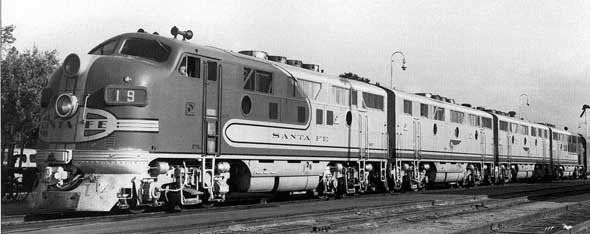|
Earlier units were also upgraded over a several years time span to have F7 appearance of the carbody sides, but they retained the raised early style roof fans. Units 16 through 21C featured the "long" version of the red warbonnet paint similar to that used on E-units to the end, however (see the styling diagrams of the F3 and F7 passenger units). Early 16 class units were delivered with single headlights, but not too long after delivery the Santa Fe installed a rotating Mars light in the upper headlight casing and a new headlight housing was installed on the upper portion of the nose door. Later units were delivered with the upper Mars light and the lower headlight arrangement. These changes seem to have been rather sporadic and the exact date for any given change is difficult to pin down, but it seems that all the 16 class had a close to F7 appearance by the very early 1950's. As time passed, many extra grab irons were added and radio antennas of several different types appeared including a flat plate type mounted on four legs centered on the cab roof on a few units, similar to the arrangement used on E-units. All the 16 class units were built with the typical F3 slit type D/B opening in the roof, but in later years some had a fan installed or had the D/B removed completely. The raised type early F3 cooling fans were often replaced with the later low profile type and many ended up with any combination of raised or low profile fans, but a few units retained all four raised fans to the end. Raised fans are even known to have migrated to a 200 class F7 or two as well, one known example being 240C. All the Santa Fe's F3's were upgraded to F7 mechanical standards by the mid-1950's. |
 F3 number 19LABC at Pasadena in December 1946 illustrates the "as delivered" appearance of 16 class units 16LABC through 21LABC. Identifying features include the three portholes, extended "E-unit" style warbonnet, "chicken wire" screens over the upper carbody openings and raised radiator fans on the roof. Compare this unit with the EMD styling diagrams. -Stan Kistler |
 Here's the same engine at the same station eighteen months later! By May 1948 the 19's two cab units have been modified with the addition of a lower headlight (Mars light installed in upper headlight housing), removal of the center porthole and installation of "chicken wire" screenings over openings cut in the side panels between the two remaining portholes. The B-units were slightly changed in external appearance. All the early F3A's (16-21) underwent these modifications within a couple of years of their delivery. -Stan Kistler |







